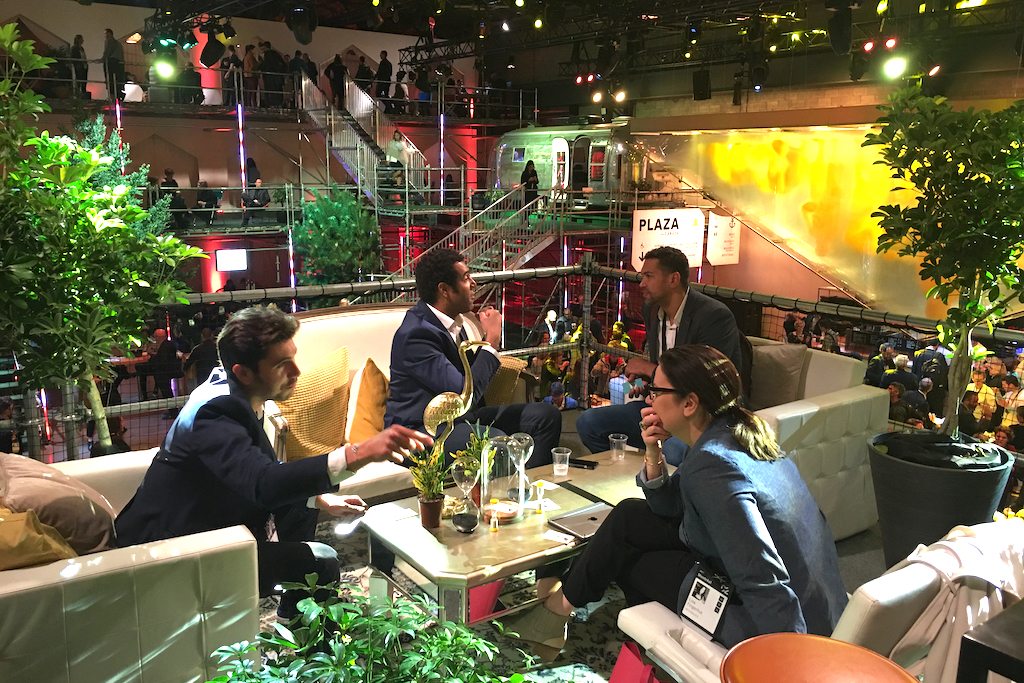Braindates to Meet Like-Minded Conference Attendees Are Becoming a Thing

Skift Take
The design strategy for the annual C2 Montreal conference last month was seemingly inspired by "Mad Max Beyond Thunderdome."
The massive, post-industrial Arsenal gallery, located in the city's bourgey, bohemian Griffintown neighborhood, was filled with multi-level scaffolding to provide an eclectic array of varied environments for the 6,000-plus attendees to share knowledge.
The Thunderdome vibe was especially evident in the all-black Agora space inside the big back hall. People gathered on three tiers of scaffolding facing a 30-foot high video wall showing the keynote sessions taking place inside the pop-up 360 Big Top venue outside.
In the main entrance hall, there was another 3-story series of scaffolding with an Airstream trailer "boardroom" and a dozen, very popular camp-style cabanas with canvas doors for small group meetings.
C2 has evolved into a global benchmark for event design since launching in 2012, but the innovation extends beyond the creative mojo and significant resources invested into the physical layout.
The show works with Montreal-based E-180 to provide a digital matchmaking platform called Braindate for attendees to find other people with like-minded interests. It's always a challenge at conferences to meet someone who might be a potential business partner or learning source, or whatever, especially when you don't know who those people are.
In recent years, dozens of emerging event technology companies have attempted to develop cloud-based personal connectivity platforms to help conference participants cull through their attendee lists. Few, however, have scaled to provide an effective solution for crowdsourced learning and networking at events.
Braindate is an exception, and it's surprisingly simple to use. It's designed to be integrated into an event app where attendees can post a one-sentence question or goal explaining their particular interest. Those posts can be tagged with any number of phrases, such as "event UX" or "smart city" or "experiential marketing" to help users streamline their search.
When someone sees a Braindate suggestion that looks appealing, he or she clicks on it to show a calendar with concurrent open slots in both people's schedules. Then that person sends a request with a specific time to meet to discuss their shared interests. It's also important to note that C2 registrants could schedule meetings pre-conference, although the bulk of activity kicked in on opening day.
Other conferences have incorporated the Braindate platform into their event design and programming, including TED Women, Airbnb Open, Salesforce's Dreamforce, and re:publica.
New this year at C2 Montreal, E-180 launched a Group Braindate scenario where a participant could schedule and host a meeting focusing on a specific topic with four other people. Interested parties would reserve one of the four open spaces, and then everyone participating could chat online within the specific Braindate page to curate the conversation ahead of time.
The Group Braindates are actually preferable in some ways because you can pull insight from more people in the allotted 45 minutes than you might with the 30-minute individual Braindates. It also provides a safer, comfortable experience for more introverted attendees, although this works best when everyone contributes to the dialogue.
Over the course of the 3-day event, E-180 hosted more than 3,000 one-on-one Braindates and 120 Group Braindates on the second-level scaffolding perched above Arsenal's entrance.
According to Christine Renaud, founder and CEO of E-180, the demand for the new group meetups exceeded the available space allotted for them.
"The feedback on the Group Braindates was phenomenal because we positioned them almost like a mini-workshop," said Renaud. "They're not so much about one person talking to four other people, but rather where a group of people can explore a common challenge together. That's the foundation for collaborative learning."
Furthermore, the Group Braindate environment and chat functionality can be scaled for larger groups and public online/offline forums such as this session at re:publica 2017. In this case, the E-180 platform works almost something like an Eventbrite or Meetup app to drive larger community engagement around any type of event dialogue.
Challenges With Web-Based App
For the last few years, E-180 developed the event app for C2 Montreal with the Braindate component integrated into the app's array of features. As buzz surrounding the Braindate experience at C2 Montreal grew in recent years, other conferences wanted to adopt E-180's proprietary matchmaking technology, except they also wanted to stick with their existing event apps.
Therefore, E-180 announced at C2 this year that it removed itself from event app design so it can scale and promote Braindate exclusively to event organizers worldwide. This opens up a much broader range of opportunities for E-180 to partner around the globe with thousands of event clients, which might want a crowdsourced learning capability plugged into their programming.
So, for C2 2017, that meant the entire event app had to be rebuilt from scratch. Unfortunately, the end result was somewhat less than satisfactory for many event participants because C2 forgot we live in a mobile-first world.
This year, Montreal-based PixMob developed a Web-based event platform for C2 called "Klik" — with the Braindate platform embedded in the user interface — instead of the typical, downloadable iOS/Android event app traditionally used for large tech/media/marketing conferences.
The obvious benefit from a Web-based event platform is that people don't have to download another dedicated app to their phone solely for the duration of the live experience. As such, however, there was a lag time whenever attendees tried to access Klik, and the site had to reload every time you moved from page to page. The portal also required users to keep logging in many times during the day.
That's a big pain point when you're running around an event floor trying to make quick decisions while paging through app sections on the fly, along with thousands of other people doing the same thing inside a highly congested space.
Attendees also couldn't add personal meetings into the Klik event agenda, requiring them to shift constantly between the Klik schedule and their email schedule, and the content describing each session and activation was often minimal to the point of being useless.
Lost in all this was Braindates. Eventually, It was easier to wait until evening to scour through all of the attendee posts in the Braindate section on the Klik website, rather than dealing with the mobile version on the show floor.
"It was a bit of a gamble this year, and I think the challenge was really big in terms of recreating the whole technology stack at C2," said Renaud. "Everyone is aware of the flaws, and we're already working on C2 2018 to correct what didn't work, and better align with customer expectations."
A representative at the Klik desk during C2 said the decision to move to a Web-based app was based on the idea that people don't want to download a dedicated event app. The employee also suggested that a Web-based platform helps ensure the information appears more uniform across different types of devices.
On a more positive note, C2 attendees could share contact information by pressing on their Klik smart badge and touching it to another person's badge to upload each other's details.
Overall, notwithstanding the event app challenges, C2 is proving itself as an effective living laboratory for testing collaborative learning and participatory event platforms designed to deliver personalized conference experiences that appeal to all age groups. Almost.
All of the pieces — including C2's Mad Max design vision and E-180's Braindate experience — are in place. The event just needs a few online/offline UX experts to anticipate how all of the hardware and software actually works together in real time when the doors open.




